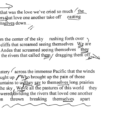The Poetry of Julio César Aguilar

Poet, translator, editor, director of poetry projects, and professor at Baylor University in Waco, Texas, Julio César Aguilar was born in Ciudad Guzmán, Mexico, in 1970. He is the author of two-dozen collections of poetry and translations—works such as Rescoldos, Nostalgia de no ser mar, and El desierto del mundo—and has contributed to several anthologies.
Aguilar is a Neo-Romantic poet whose works have a quality often sought after by current postmodern poets, but especially effective for romantic poetry. It’s a kind of slippage. The links between feeling and image, feelings, images, are effaced, and only instinct and emotion connect. The visual and the emotional are entwined.
Reading Aguilar’s poetry gives one a sense of his unbounded imagination, electrical intuitive connections, and unconventional spirituality. Written in Spanish, it is yet poetry that an English speaker with limited knowledge of Spanish can relate to. Some of his work has been translated, but even a brilliant translation never catches the full effect of the original.
Transparencia de lo invisible (Transparency of the Invisible) places the English version side by side with the Spanish. This is the book to begin with for the reader who has little Spanish. The poems are image-rich and evocative, and create an impression of a persona and a culture. The first person I of Aguilar’s poems is unusual—sometimes it seems to represent the poet’s voice but it is also the voice of a time and place. Elsewhere it seems to be a solipsistic sentience, alone in a mysterious world. At yet other points the I seems to be a kind of collective unconscious. There is transcendence in this work as the speaker returns to his origins to work through his experience and find his place as a poet, dreamer, and human being. One of my favorites is “La consigna y el milagro,” which begins:
Volver a tus dominios, infancia,
acercarse es lentamente
a la explosiva boca de un volcán
y luego, ¿para qué volver entonces
al origen del desastre
donde aún el escombro
es el reino de la insania
y una voz de látigo, férrea
para el castigo y la zozobra
hace cumplir puntualmente su mandato?
With his colleague Alicia Zavala Galvan, Aguilar translates this as “The Summons and the Miracle”:
To return to your dominions, childhood,
is to slowly approach
the explosive mouth of a volcano
and why then return
to the origin of the disaster
where rubble is still
the kingdom of insanity
and the whip of a voice
harsh to punish and anguish
make it punctually carry out its orders?
This could be seen as anti-Wordsworthian, possibly even anti-romantic, but it is not. It is the beginning of a quest. The answer finally:
Regresar a la infancia
y salvar al corazon de su infortunio
han de ser la consigna y el milagro.
(“To return to childhood / and rescue the heart from its misfortune / should be the summons and the miracle.”)
The power of childhood memory and the meaning of family are important themes throughout Aguilar’s work. Another theme is the poet’s compulsion to write. The poem seems to invade the poet and overwhelm him. It comes from outside and is met from within.
Porque sólo el silencio es sabio
y la sustancia suya
un bálsamo de qué inconocido origen,
vengo
a mirar y a nada más mirar
cómo la noche se acaba
(“Because only silence is wise / and its substance is / a balm of unknown origin, / I come / merely to see and look at / how the night finishes.”)
But ultimately
La sola palabra mía
mirando
con su toda mudez asombrada,
solamente mirando cómo a la noche
silencioso y rotundo
le creció el poema.
(“My single word / sees / with all her astonished muteness, / seeing simply how the night / rounded and quiet / grew within her a poem.”)
Aguilar’s 2008 collection Barcelona y otros lamentos (La Zonámbula, Guadalajara, Jalisco) is the collection that is most explicitly about the nature of poetry, what it becomes for the writer and the reader. The poems in this book tend to be expansive, or they are groups of related poems that work their way around a concept. Sections have labels and sometimes epigraphs; Metáfora en Mano, for me the most compelling segment, contains quotations from Octavio Paz, Pablo Neruda, and Juan Ramón Jiménez as a foreword. The Octavio Paz passage is particularly telling:
entre lo que veo y digo
entre lo que digo y callo,
entre lo que callo y sueño,
entre lo que sueño y olvido,
la poesía.
between what I see and say
between what I say and hush,
between what I hush and dream,
between what I dream and forget,
poetry.
Metáfora en Mano is a sequenced meditation on what poetry is and can be:
Esto que un día fue solitaria planicie
la sola
tan en blanco página inexistente
poblándose de pronto
ver-ti-gi-no-sa-
mente
está de signos
de invisibles palabras mudas
de ocultas constelaciones.Tú
distraído en tu ceguera
que por aquí pasas
¿algo miras?
This that one day was a solitary plain
the single
inexistent blank page
is filling itself suddenly
ver-tig-in-ous-
ly
with signs
of invisible silent words
of hidden constellations.You
distracted in your blindness
that pass by here
do you look at anything?
The sections give a sense of Aguilar’s struggle with silence, a struggle that has to take place—the poet may be compelled to write, but they are not always given the words. The sequence ends with a sort of prayer:
enseñarme a hablarla
o enmudecerla
hasta que su silencio
me niegue u olvide
o ya por mi nombre
me llame.
teach myself to speak about her
or to mute her
until her silence
denies me or forgets me
or by my name already
calls me.
A recent beguiling collection, Perfil de niebla (2016) contains a series of reflections about the physical and the metaphysical. The title is a capsulated presentation of theme and spirit: “Profile of Fog.” But fog does not have a profile; it takes the poet to invent and discover the outlines of what is hidden in the chaos of our experience. Poetry results from the separation of man and world, and from observations of unity and separation. The poet has to bridge the gap between self and world, and is moreover compelled to do so. The other speaks. The poet records. The poems of Perfil de niebla demonstrate his use of powerful archetypal images:
I
Nadie como él
en su afán de darseAmante invisible
en la calle
guarda nada
para síII
De espaldas
al mundo,
esconde el rostro
en las sombras
la luz
I
Nobody like him
in his eagerness to giveInvisible lover
on the street
save nothing
for himselfII
Backwards
to the world,
hide the face
in the shadows
the light
The poems are divided into two groups, “Rescoldos” and “Brevesencias.” The first part explores life’s mysteries and ironies and the second, those of death. “Rescoldos” opens expansively, while “Brevesencias” tends to draw back. The poems demonstrate how an imagination works while exercising it. Melting outlines and suggested shapes pervade the work, and although it is not always about creativity or the creative impulse, it is always indirectly about that. Perhaps could that be said of all poetry? The passage on the back cover captures the feeling of the whole:
Se incendia, el tiempo, de sí mismo;
y en su siempre llama
hoguera que devora todo
y lo convierte en polvo de la nada
manantial de sombras
la muerte nos reaviva
perpetua, a fuego lento
It burns, time, of itself;
and in its constant flame
bonfire that devours all
and turns it into dust of nothing
spring of shadows
death rekindles us
perpetual, simmering
The basic images are elemental. Their meanings grow by accretion. They allude to shades of art and life.
I have always found it rewarding to read books in languages that are not native to me, even languages that I don’t know well. Not even the best translations of Paul Celan can catch the full naked anguish of his poetry, for example. And I’ve always liked to read the poetry of Yannis Ritsos, although I’m aware of how much does not come through in translation. Still, it’s valuable to read across cultures.
Aguilar’s poems should be read in Spanish, even by those who don’t speak the language well. The meaning is the spirit of the poem, but the words are its body. Even when I am not fully aware of the exact meaning in Spanish, I feel its heft in my mind. The poems of Julio César Aguilar are filled with mystery and promise.
About Janet McCann
Janet McCann's poetry has been published in Kansas Quarterly, Parnassus, Nimrod, and elsewhere. A 1989 NEA Creative Writing Fellowship winner, she has taught at Texas A & M University since 1969. McCann has co-edited two anthologies, Odd Angles of Heaven (1994) and Plae pf Passage ( 2000), coauthored two textbooks, and written a volume on Wallace Stevens, The Celestial Possible: Wallace Stevens Revisited (1996). Her most recent poetry collection is The Crone at the Casino (2013, Lamar University Press). Her reviews have appeared in theWomen's Review of Books, Christianity and Literature, and Texas Review, among other journals.





